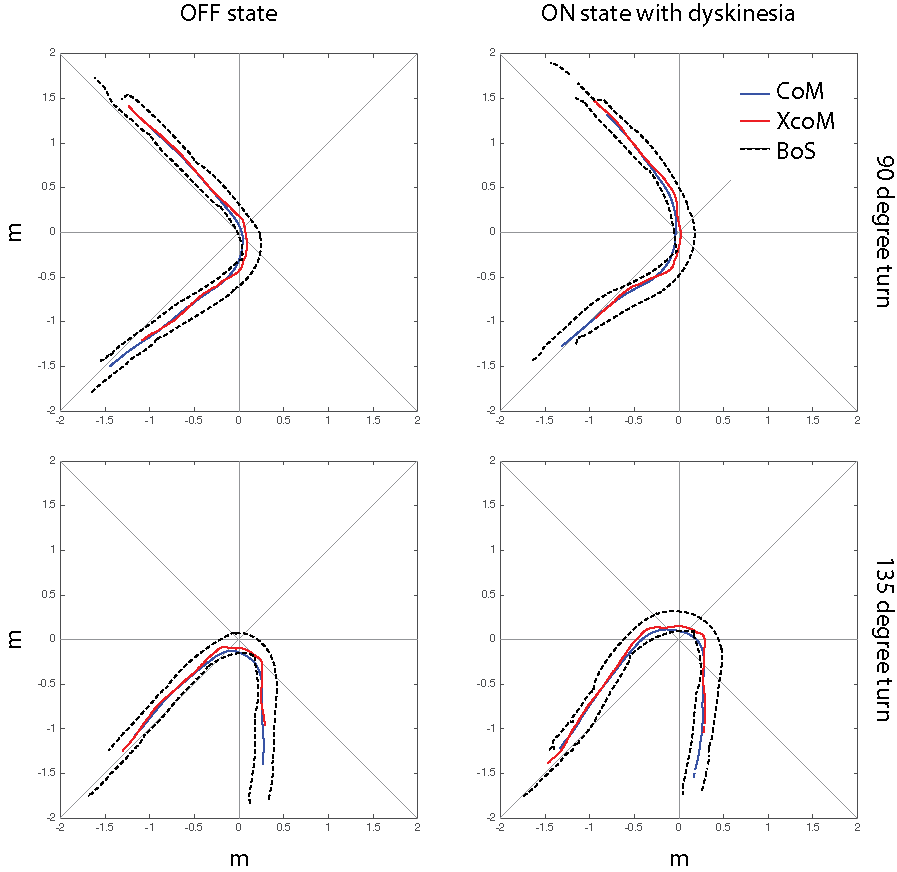Session Information
Date: Tuesday, June 6, 2017
Session Title: Parkinson's Disease: Pathophysiology
Session Time: 1:45pm-3:15pm
Location: Exhibit Hall C
Objective: The goal of this study is to determine the contributions of dyskinesia to abnormal turning mechanisms.
Background: The ability to turn safely while walking is crucial for functional mobility. Even early in the disease, people with Parkinson´s (PD) experience difficulties turning. Recently, we showed that people with PD who have dyskinesia walk and turn more quickly when taking levodopa, but become unstable during standing and fall more in daily life.
Methods: Participants performed preplanned turns to the left and right, at different turn amplitudes (45, 90, 135, and 180 degrees) while walking at normal and fast speeds. Floor markings similar to a clock face consisting of a turning point in the center and turn angle marks in the periphery were used as guidance to indicate turn size. Participants were tested in the practical OFF state, after withholding their antiparkinsonian medication for at least 12 hours. Subsequently, they were retested in their ON state, 1 hour after taking a supra-threshold dose of levodopa; i.e., 1.25 times of their regular dose. To capture full body kinematics and center of mass (CoM), 30 reflective markers were attached to the participants’ anatomical bony landmarks. The markers were tracked using a 12-camera motion analysis system sampling at 120Hz.
Results: Preliminary results suggest that people with PD walk and turn faster when in the ON medication state. Furthermore, participants turned with a wider arc when ON medication. This was even more prominent in people with PD who showed clinical signs of dyskinesia during testing in the ON state (see Figure 1). Figure 1 illustrates turns of 90 and 135 degrees at fast walking speed of the same individual. Gray lines are given as reference for the turn angle in increments of 45 degrees. Trajectories of the CoM (blue line) and the velocity adjusted position of the CoM (i.e. extrapolated CoM (XcoM), red line) are shown with respect to the base of support (BoS, dashed line), which was defined by the excursion of the lateral malleoli. Dynamic stability is reduced when the XcoM is outside or very close to the stepping BoS. [figure1]
Conclusions: The increase in turning speed and wider turn radius are signs of disinhibition in PD with levodopa-induced dyskinesia. This disinhibition may lead to more unsafe turning strategies. Further analysis will be performed to confirm our observations.
To cite this abstract in AMA style:
C. Curtze, P. Fino, S. Smith, P. Carlson-Kuhta, J. Nutt, F. Horak. Dynamic stability during turning in people with Parkinson’s disease [abstract]. Mov Disord. 2017; 32 (suppl 2). https://www.mdsabstracts.org/abstract/dynamic-stability-during-turning-in-people-with-parkinsons-disease/. Accessed December 30, 2025.« Back to 2017 International Congress
MDS Abstracts - https://www.mdsabstracts.org/abstract/dynamic-stability-during-turning-in-people-with-parkinsons-disease/

